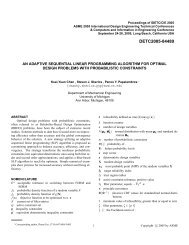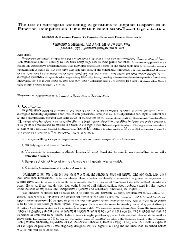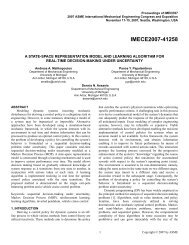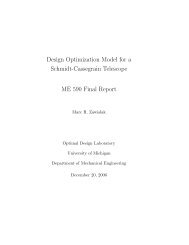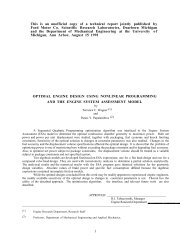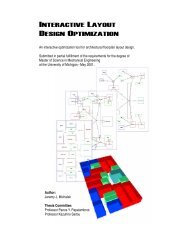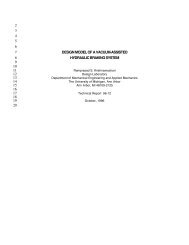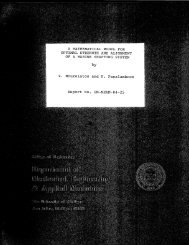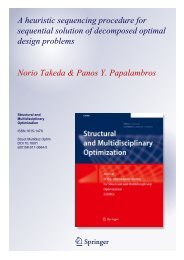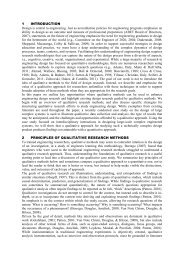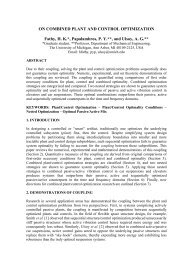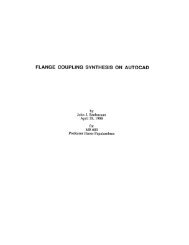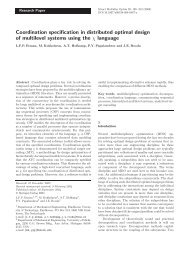Decomposition Analysis of an Automotive Powertrain Design ...
Decomposition Analysis of an Automotive Powertrain Design ...
Decomposition Analysis of an Automotive Powertrain Design ...
You also want an ePaper? Increase the reach of your titles
YUMPU automatically turns print PDFs into web optimized ePapers that Google loves.
g 13 : ξ 1 / ξ 2 - 2.0 ≤ 0 Step down ratio constraint<br />
g 14 : 1.2 - ξ 2 / ξ 3 ≤ 0 Step down ratio constraint<br />
g 15 : ξ 2 / ξ 3 -1.6 ≤ 0 Step down ratio constraint<br />
g 16 : n gears - 0.5 - ξ 1 / ξ ngears ≤ 0 Gear sp<strong>an</strong> constraint<br />
g 17 : ξ 1 / ξ ngears - n gears - 0.5 ≤ 0 Gear sp<strong>an</strong> constraint<br />
g 18 : 0.8 - b/s ≤ 0 Bore-stroke ratio constraint<br />
g 19 : b/s - 1.2 ≤ 0 Bore-stroke ratio constraint<br />
g 20 : 400 - π b 2 s/ (4 n c ) x 10 -3 ≤ 0 Displacement/cylinder constraint<br />
g 21 : π b 2 s/ (4 n c ) x 10 -3 - 600 ≤ 0 Displacement/cylinder constraint<br />
g 22 : d i + d e - 0.88 b ≤ 0 Valve size constraint<br />
g 23 : 0.85 - d e /d i ≤ 0 Valve size constraint<br />
g 24 : d e /d i - 0.87 ≤ 0 Valve size constraint (91)<br />
g 25 : (i vo - e vc ) / 50 - 1.0 ≤ 0 Valve event constraint<br />
g 26 : acc iv (i vo , i vc, i lift ) - K acci ≤ 0 Valve acceleration constraint<br />
g 27 : acc ev (e vo, e vc, e lift ) - K acce ≤ 0 Vavle acceleration constraint<br />
h 1 : d bm /b - K dm = 0 Main bearing diameter constraint<br />
h 2 : l bm / b - K lm = 0 Main bearing length constraint<br />
h 3 : d br / b - K dr = 0 Rod bearing diameter constraint<br />
h 4 : l br / b - K lr = 0 Rod bearing diameter constraint<br />
h 5+i : i = 0, ..., 56 Defining model equations<br />
4 PARTITIONING<br />
The FDT <strong>of</strong> the optimization model <strong>an</strong>d its undirected graph (adjacency matrix) are shown<br />
in Figure 9. Partition metrics include: (i) preference for a feasible coordination strategy which<br />
implies a search for linking variables, (ii) at least two disjoint partitions having at least 20 functions<br />
each, (iii) the smallest number <strong>of</strong> linking variables (but not to exceed ten). The heuristic search<br />
scheme for acceptable partitions is:<br />
1) R<strong>an</strong>k variables according to the number <strong>of</strong> times each appears in the FDT, initialize counters i<br />
<strong>an</strong>d j to 1.<br />
2) Construct a vector <strong>of</strong> linking variables, y i , starting with the first highest r<strong>an</strong>ked variable.<br />
3) Delete y i from FDT, perform depth-first-search on the graph <strong>of</strong> the modified FDT, <strong>an</strong>d test<br />
partitions against acceptability criteria.<br />
4) If acceptable, store y i as a c<strong>an</strong>didate vector to be enumerated.



